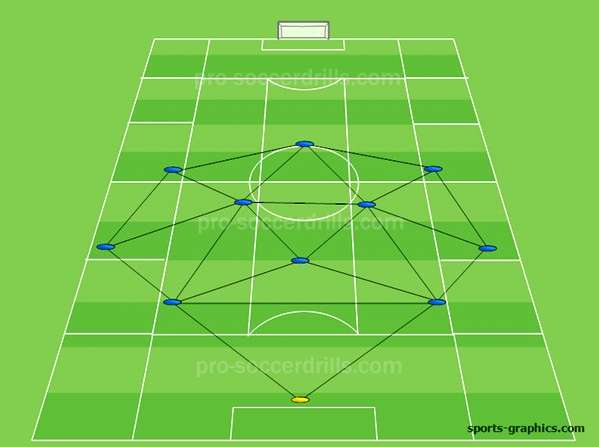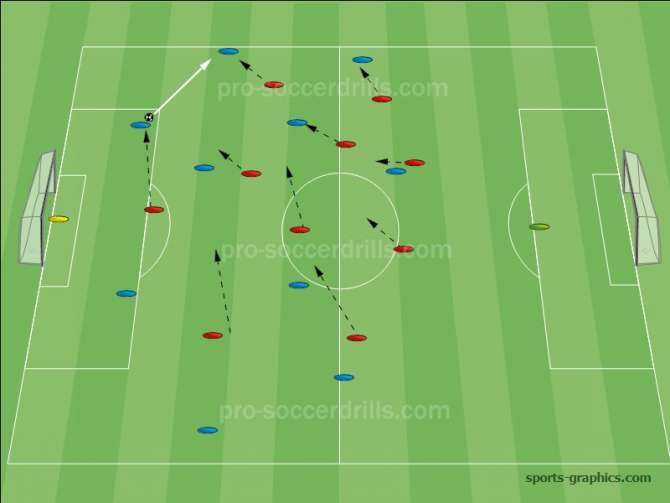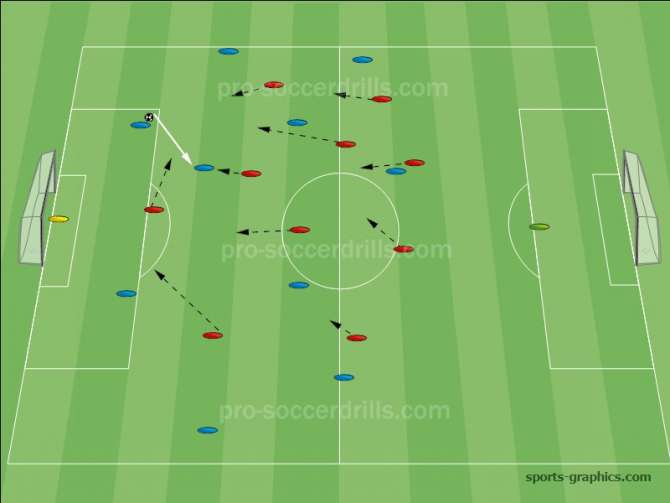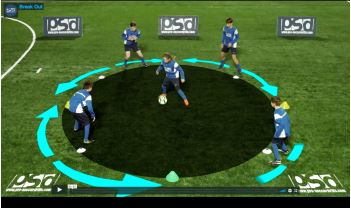The Principles of the Gegenpressing
Soccer coaches and theorists often claim that soccer has four phases: In Possession, Out of Possession, Transition to Attack, Transition to Defence. There are many ways of attacking and there are of course many possibilities and opportunities to avoid conceding goals. This article presents the reader the transition play to defence and the defending itself through a tactics (and a form of getting the ball back) called Gegenpressing.
This counter-pressing style dominated English football in the 1980’s and Gegenpressing is the modern form of it basically. There are many World-class soccer trainers that use this when out of possession, p.g. Thomas Tuchel, Jürgen Klopp, Marcelo Bielsa or Pep Guardiola. There are three main approaches to Gegenpressing.
This counter-pressing style dominated English football in the 1980’s and Gegenpressing is the modern form of it basically. There are many World-class soccer trainers that use this when out of possession, p.g. Thomas Tuchel, Jürgen Klopp, Marcelo Bielsa or Pep Guardiola. There are three main approaches to Gegenpressing.
The first type of Gegenpressing
This form of getting the ball back (and avoid conceding a goal) was developed by the USSR and the Netherlands in the 1960s and then spread through the whole World. The main idea was to get the ball back as soon as possible, so what did they do? Started to put instant pressure on the opponent on the ball as soon as possible. The way they did it, that every player started to sprint towards the man with the ball. The team out of possession left many opponent unmarked but if they put instant pressure on the man with the ball, he couldn’t make a long ball behind the pressing players.
There’s a video about it: The hard pressing of Total Football.
The idea can be seen. The players saw a trigger, for example the nearest man to the man on the ball started to sprint towards (Pressure player) the ball and all the other teammates followed him. There are also triggers for the Pressure to press. These triggers can be a backward pass, a wrong ball control, lost control, ball on weaker foot, lost balance, etc. These pressing triggers still exist today and many coaches use these. There was another advantage: when the team is short (there is only a 25-30-meter distance between the first and the last player [apart from the keeper]) it can be used as an offside-trap. As Johan Cruyff once said: “Offside trap is an attacking tactics.”.
There is an article about the roles (in attack and either in defence) in modern soccer including the Pressure, the Cover and the Balance players: The Importance of Triangle in Soccer.

Nowadays soccer has become so fast and technical that teams can’t play this kind of pressing play. But it was a revolutionary invention at that time.
Tip: Coaches coaching younger age groups can use this kind of pressing. It will give the kids success as they get the ball back sooner because the player on the ball can’t play a longer pass at that age. So this will also develop the player with the ball at his feet to analyse, decide and play faster. Later kids will change but they will have a great mentality on and off the ball, too.
The second type of Gegenpressing
After the Netherlands and the USSR’s pressing game, soccer became faster in possession: players started to make faster and more accurate decisions and intelligence became the most dominant factor of playing soccer. Gegenpressing is physically quite tiring and exhausting for players to execute many times because players have to make many of 10-20-meter sprints. The question is: can you play Gegenpressing tactics with players that are more intelligent than physically well-built? The answer is yes: there is a way (or two) to put large pressure instantly on the man with the ball and avoid balls behind the defence. This solution would be the second type of this tactics.
What the team did is they went for the ball as soon as they lost it. There was a 3-5 second rule and started to press as soon as they could as rapidly as they could. The three, four or five players around the ball made a sprint towards the ball while the other teammates man-marked the players nearby. This also let the long-ball option, but there were further players that controlled areas. This Gegenpressing have to be organised but also requires a high level of fitness. (RSA: Repeated Sprint Ability) As it requires physical attributes and performance, it also requires mental, cognitive abilities to read the game fast and only then execute controlled movements. This is why there is a need of good athletes and intelligent thinkers for this soccer tactics out of possession. Players need to react quickly for transitions.
There is a soccer game that includes and develops reaction of the players: 1v1 Decision Making and Reaction.
In this situation the trigger was the zonal pass, that can be called a “pressing pass”. Players instantly marked the nearest man to the ball possessor while the ball is on the move.

There is a sub-variation of this tactics that presses the ball with one man and the other players instantly run towards a free man to mark. This is a great idea on the opponent’s half as the player on the ball has to decide whether he takes a risk in such a dangerous area or not.
The third type of Gegenpressing
As it was explained before, the other two types of Gegenpressing requires a huge physical performance. What if you have intelligent but small players that are not that fast as others and still want to play the pressing game? This is the problem, Pep Guardiola, FC Barcelona and the whole Spanish football faced in the 2000s. They had outstanding players like Iniesta and Xavi but they weren’t that strong in physical attributes. Players like these have limits so they have only one chance: to outplay the opponent using their cognitive abilities and game-intelligence. Spanish football has invented the third type of Gegenpressing.

In this situation the trigger was a man (defensive midfielder in blue) facing his own net with the ball so players started to put pressure on him while trying to cut many passing options.
The difference between this and the second type is that players surrounding the ball close down passing lanes instead of marking free men. The question can be obvious: why does it require less fitness than the second type? The answer is because players don’t have to run 5-10 meters more if they are able to cut passing lanes. It is more challenging mentally as they have to read the play behind their back where the “un-marked” opponents are. Moreover, players playing this kind of pressing game have to do it in a fraction of a second. Players need to be developed from such a young age playing a smart game like that because they need an adequate quantity of stimulus to develop their brain to become receptive of the actual surroundings.
Coaching the Gegenpressing
It is quite hard to coach this kind of defending nowadays. It needs the players’ level of understanding and interpreting the game more than coaches can teach it step-by-step. Depending on the type we teach it is obvious that Gegenpressing gives the players and idea and a mentality of getting the ball back. As it was written before, it also makes the game faster as players spend less time on the ball, making faster decisions and executing football technique faster and more accurately if they didn’t want to lose the essence of this game: the ball.
Gegenpressing can be used in the transition phase (from attack to defence) as well as in the defending (out of possession) phase:
1. In the transition phase players react as quickly as they can and go for the ball with the highest intensity for 5 to 6 seconds approximately. If they couldn’t win the ball back, they cannot be asked to chase it for more as it would be really tiring (especially for kids) and possession would be a great way for the opponent to outrun our team.
2. In the defending phase there should be signals or triggers when and how to start counter-pressing. These triggers (or zones) can be coached and organised well. Trigger can be anything from the following examples:
- A backward pass
- A slow pass
- A bad touch, wrong control
- Player facing his own goal with the ball
- Ball on the ball carrier’s weaker foot
- Lost balance
- Target player (weakest of the opponent)
- Target zone (where the ball is not dangerous for our team)
- Etc.
Summary
Gegenpressing is often called counter-pressing. It became a famous football terminology in the recent years when Germany won the World-Cup, Bayern Munich won the Champions League (playing against the German Borussia Dortmund in the final) and many more teams started to use the second type of this tactics. We could have called this defending attitude Counter-Pressing during the whole article but Gegenpressing became a Worldwide expression in the field of soccer.
Lastly, we suggest you a great article on this: Counter- or Gegenpressing.
Free Trial
GET YOUR FREE 14 - DAYS TRIAL NOW! INCLUDING:




